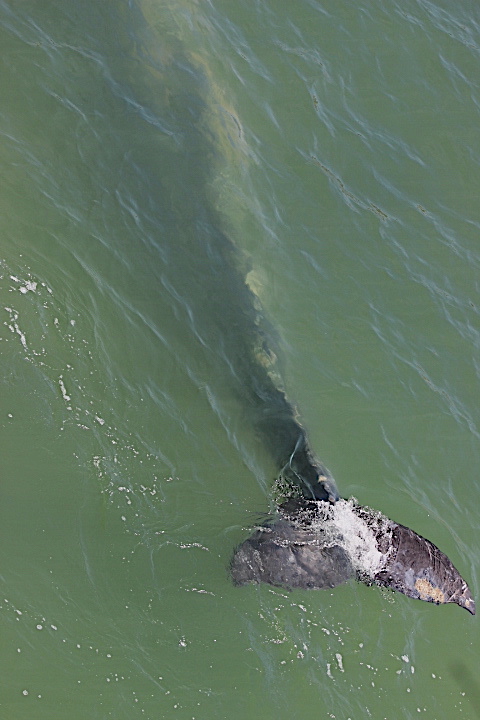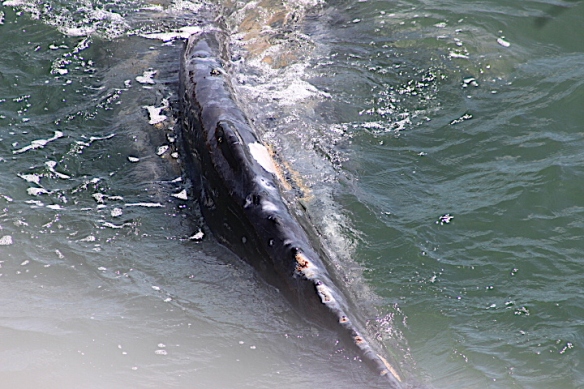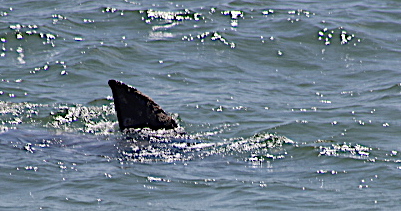The Full Sturgeon Moon rises tonight. A perfect time to set intentions and believe in magic!
I wonder if these intense lunar energies had anything to do with a baby gray whale who lost his way in our little beach town entering Agua Hedionda Lagoon from the ocean.
I happened to be in the right place at the right time with my lovely Canon and a decent lens and was lucky enough to snap these photos.
SeaWorld came to assess the situation and told me that he didn’t seem to be in distress; he was spouting every couple of minutes or so, which is completely normal, and he was rubbing his body against the rocks to try and dislodge all of the barnacles.
I did a little research and learned this about barnacles…
from https://www.learner.org/jnorth/tm/gwhale/Hitchhikers.html:
Gray whales are more heavily infested with a greater variety of parasites and hitchhikers than any other cetacean. Imagine carrying a load of hitchhikers on your back that can weigh several hundred pounds! Gray whales do this all their lives. Who’s riding, and why?
Big Batches of Barnacles
Those patchy white spots you see on gray whales are barnacles. Grays carry heavy loads of these freeloaders. The barnacles are just along for the ride. They don’t harm the whales or feed on the whales, like true parasites do. Barnacles don’t serve any obvious advantage to the whales, but they give helpful lice a place to hang onto the whale without getting washed away by water. Barnacles find the slow-swimming gray whale a good ride through nutrient-rich ocean waters.As larvae, the whale barnacles swim freely in the ocean. But they time their reproduction so the larvae are swimming in the water of the nursery lagoons when the baby whales are born. Then the larvae jump aboard the whales arriving in the lagoons–as well as the newborn calves—to start their lives as hitchhikers. The most common barnacles on gray whales are host-specific, which means they occur on no other whales. One type of barnacle, Cryptolepas rhachianecti, attaches only to gray whales. Once this type of small crustacean has settled on “its own” gray, the barnacle spends its whole life hanging onto that whale.
Life is good if you’re a barnacle. Snug inside their hard limestone shells, the barnacles stick out feather feet to comb the sea and capture plankton and other food for themselves as the whales swim slowly along. As the young whales grow, the barnacle clusters grow too. Gradually the barnacles form large, solid white colonies. The colonies appear as whitish patches, especially on the whale’s head, flippers, back and tail flukes.
Whale biologists look at the pattern of barnacle clusters in order to tell individual grays apart. This is possible because no two barnacle clusters, like no two human’s fingerprints, are alike!
When the tide changed, he finally made it out beyond the jetty waves; hopefully he finds his mom and doesn’t wander into shallow water again!
Just another amazing day in paradise. So much magic and beauty to be grateful for!







Whale or SHARK?



My own little embellished-with-sparkles-gray whale rock is much happier barnacle-free, don’t you think?


Those are awesome photos!! I didn’t realize barnacles attached so fast and furious that a baby whale would have so many. Makes me itch just looking at them!!
LikeLiked by 1 person
I felt so badly for him, the barnacles are so close to his EYE!! Apparently he’s ok, we’ll see if he made it north or is back tomorrow.
LikeLiked by 1 person
Yes, that must be so annoying to him! No wonder they rub against everything trying to get those things O F F !!
LikeLike
Oh Rosebud, if I may be so familiar, you do live in a magical part of the world and I love your view of it. The pics are wonderful. I had no idea so many barnacles attach to a wee whale. Will he lose them when he gets older?
LikeLiked by 1 person
I actually don’t know much about barnacles except whales seem to want them OFF. I’ll do a bit more research and add it to my post. It really is a beautiful part of the world to call home, that’s for sure! How are you?
LikeLiked by 1 person
Doing well here in southern Ontario and intrigued with life in SoCal. -Though not enough to move there lol
LikeLiked by 1 person
Maybe not move here, but how about a visit??
LikeLiked by 1 person
One never knows what the future may bring. It would be lovely!
LikeLike
Oh! and I never heard of a Sturgeon Moon but will be making wishes!
LikeLiked by 1 person
I took some pretty cool photos of the moon and will post them too!
LikeLiked by 1 person
I LOVE THOSE PHOTOS!!!!!!!! Thank you for sharing! You certainly received a gift that day! xo
LikeLiked by 1 person
It was a really magical day, I framed one of the pics to remind me, cos those eyes were so intelligent when they looked right at me!
LikeLiked by 1 person
Pingback: Baby Whale Retrospective #wordlesswednesday | Enchanted Seashells by Princess Rosebud
I had no idea about the barnacles open whales being like a fingerprint. This is an all around bright post. Thanks for the link from Succulent Whale Memories.
LikeLiked by 1 person
That was such a special day for us who live near the lagoon. I took about a thousand pics.
LikeLiked by 1 person
Cetaceans are da bom. You can feel them sounding you, and sometimes even sound back. I bet that was a very special day.
LikeLiked by 1 person
The best moment was when s/he looked at me and our eyes locked on each other for a nanosecond before s/he blinked and got even closer to grounding. I just stood there, no pics of that, just my memories. I was actually close enough to reach out and scratch those barnacles but knew I shouldn’t. Plus the police and marine mammal experts were right there.
LikeLiked by 1 person
That’s the kind of connection I’m talking about. Eye to eye, even for a short time, feel it all through you. I love big cats and animals in general, and have had my share of experiences up close with a big cat eye to eye in the wild, though there is nothing that compares to a whale or a dolphin are I bet a killer whale… those cetacean eyes… they spill the Universe into yo.
That is wonderful you were so close. I’m frankly surprised you didn’t reach out, and since you didn’t, then that’s the perfect way for it to have shaken out. Are those “Old Man’s Bones” spilling over the front in the picture?
Eyes locked on each other. I hope you are able to keep that, and I love the repurposed “Eyes Locked Memory Seed” of the Baby Whale spitting up succulents as a reminder to keep that memory watered. 🙂
LikeLiked by 1 person
I’ve felt that connection with most animals and all the wolves I’ve worked with, too. And the one mountain lion I was lucky enough to help rehab. And a hawk that didn’t notice how close I was because I made myself invisible I guess. I wrote a post about that encounter. Kind of the same connection I had with the Dalai Lama too. But that’s only cos he’s so amazing.
LikeLiked by 1 person
🙂 Niiiice! THose are some wonderful animals, apex of intensity.
The Creation Story in the beginning of my “ImaginAction” pdf eBook reels out my mountain lion experience. They are special, special beings.
LikeLike